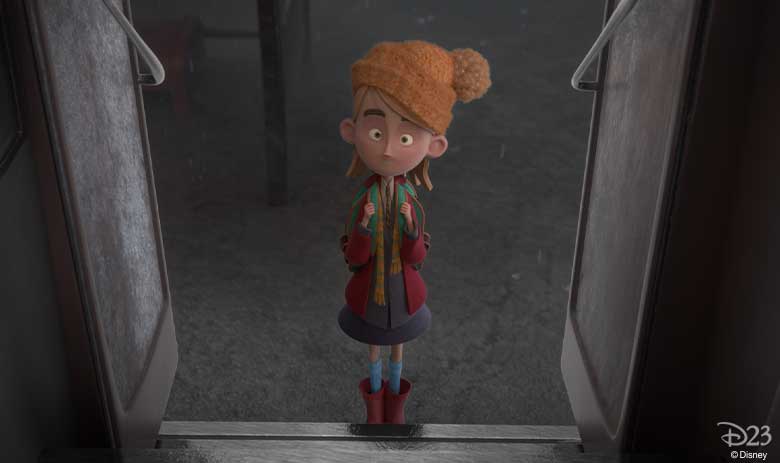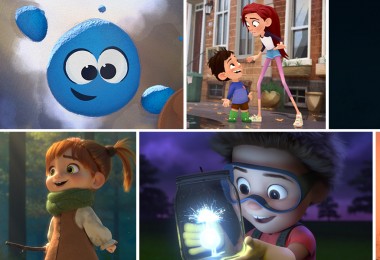By Zach Johnson
Short Circuit, Walt Disney Animation Studios’ innovative and experimental short film program that enables anyone at the Studio to pitch an idea and potentially be selected to create their own short, is marking the fifth anniversary of its inception with the exciting debut of five new shorts, exclusively on Disney+. The shorts debuted on the streaming service this week, after the first group of Short Circuit Experimental Films debuted in 2020.
The goal of the Short Circuit program is to take risks in both visual style and story; surface new voices at Disney Animation; and experiment with new technical innovation in the filmmaking process. Drawing on the support of the Studio and their fellow artists, each director has a set time and budget to create their personal vision for the film. The five shorts featured in the second season of Short Circuit are Crosswalk, directed by Ryan Green; Dinosaur Barbarian, directed by Kim Hazel; Going Home, directed by Jacob Frey; No. 2 to Kettering, directed by Liza Rhea; and Songs to Sing in the Dark, directed by Riannon Delanoy.
“We are so excited to be premiering these five new Short Circuit films on Disney+ and feel that this is a great way to share these entertaining, unique and often personal stories with the widest possible audience,” says Jennifer Lee, chief creative officer, Walt Disney Animation Studios. “The program is open to everyone within Disney Animation, and the projects are selected based on their merits and without knowing who is making the pitch. There has been such great enthusiasm and excitement for the program, and it has allowed us to boldly experiment with new technology and techniques, give opportunities to aspiring directors and to tell unique stories.”
Jennifer Newfield, who joined Disney Animation in 2008, oversaw the second season of the Short Circuit program. Newfield—whose credits include The Princess and the Frog, Tangled, Prep & Landing: Naughty vs. Nice, and the upcoming Iwájú—worked closely with each of the filmmakers, guiding them from the pitch process through the various phases of pre- and post-production. She served a similar role for many of the previous Short Circuit films from the first season, working alongside then-production manager Nicholas Russell.
“The selection group for the Short Circuit program is usually comprised of as many as 10 filmmakers and creative development folks from throughout Disney Animation,” Newfield explains. “This group can also include technical and visual effects supervisors, and previous Short Circuit directors. Their top priority in selecting a pitch is the storytelling aspects. They’re looking for something that is a good story that works within a (roughly) 90-second timeframe, something new and interesting, and something that we haven’t explored before at the Studio.” Songs to Sing in the Dark “is a really good example” of the kind of story she just described. “Director Riannon Delanoy is an animator who wanted to visualize an auditory experience with a really interesting experimental aspect,” Newfield says, “because her film doesn’t specifically have a beginning, middle and end type of story.”
Once a pitch has been selected, Newfield matches a director with a Short Circuit advisor. “People step forward to express interest in each project, which is wonderful. We go around to the various departments doing roadshows and letting everyone know what the shorts are about. Then we ask if anyone would like to participate as an advisor, a guide and/or a mentor within their department,” she says. “The beauty of Short Circuit is that the program is outside the paradigm of the regular creative development process. It’s freeing for the directors and doesn’t necessarily follow the typical Studio process for making a film.” Walt Disney Animation Studios president Clark Spencer and Lee are big supporters “because they love the innovation that comes out of it,” she adds. “There are some great talents who have risen to new heights as a result of this program—and that is really rewarding, to be sure.”
Want to know more about the second season of Short Circuit? Read on…

Crosswalk
Inspiration struck when veteran Disney Animation story artist Ryan Green was waiting to cross the street that separates Walt Disney Animation Studios from The Walt Disney Studios main lot in Burbank, California. As he stared at the “Don’t Walk” sign and gazed for miles down the empty street, he began thinking of the trade-offs between personal freedom and social living. And, being a story artist with an active imagination, this led to thoughts about being a biological survival machine that has evolved over 3.8 billion years, and what his ancestors that risked their lives to cross the Atlantic Ocean would think about him standing there waiting for the light to change. From this “dichotomy of thought,” the pitch for Crosswalk was born. When he got the “green light” to make the movie, his editor even returned to the crosswalk where it all began to tape the beeping sounds of the light itself!
“I wanted the film to have this evolutionary concept and we decided to package that information as a backstory intro. This allowed us to get the audience on board with the subtext up front and set up the framing before we see the more surface-level ‘man versus machine’ conflict,” Ryan says. “It also allowed us to try different styles of animation in the film. The opening, which I animated myself, is very much 2D, while the rest of the film has kind of a stop-motion feel with a clay character and lots of texture. I wanted the film to have an editorial cartoon quality, but in CG, and that led to the idea of having this miniature, exaggerated set where all of the elements point back to our character’s struggle. Most importantly, I wanted the audience to have fun with this satirical look at social living versus freedom.
“Working on this Short Circuit film was a great experience,” Ryan adds. “I’ve always worked within the constraints of someone else’s vision, and this presented a whole new experience. And even though it’s a very light-hearted piece, I did some deep soul searching. Why did I really resonate with this topic? Why was it important to me? And what was the exact theme I was trying to get across? had to make all those final decisions that I never had to make before.”

Dinosaur Barbarian
For Kim Hazel, Dinosaur Barbarian is the culmination of everything she holds near and dear to hear heart. “I’m a child of the ’80s, and I grew up loving cartoons,” says Kim, a Disney animator. “But you only ever see the superheroes from those shows being heroic. I started thinking about how they handled everything else in their lives and their work-life balance. Do they ever stop and eat a meal or do anything else that normal people do? It seemed like the perfect story to tell in 90 seconds, and telling it through the framework of a theme song for an imaginary show seemed like a great pitch for the Short Circuit program.”
“When you think of cartoons from the ’80s, most people tend to think of the theme songs where they’re always doing heroic things,” Kim continues. “I thought the easiest way to subvert that trope and have some fun with it was through the song. I have always been a big fan of humor that sets up expectations and then does something the opposite of that. When they told me that my short film had been accepted, I was in disbelief. I remember feeling like Anne Hathaway in The Princess Diaries when she found out she’s a princess.”
Kim had written a few lyrics for the theme song which went along with her original pitch. She subsequently wrote out what she called her “poem” (a rough first pass of what she wanted the song to be) that laid out the story structure for the short. After reviewing several options for composers brought to her by the music department at Disney Animation, she chose Mondo Boys, two guys named Mike who had written scores mostly for horror films (and the Short Circuit film The Race). They ended up writing the score and providing lyrics for the song, along with Kim, who also landed a lyricist credit.
In keeping with the style of animated TV shows from the ’80s, Kim decided on hand-drawn 2D animation, and enlisted guidance from legendary animator Mark Henn and 2D animation veterans Alex Kupershmidt and Randy Haycock, as well as CG animators who wanted to try their hand in that style. Dinosaur Barbarian is the first Short Circuit film to be fully animated by hand. “The joy of directing a film for Short Circuit is getting to interact and collaborate with so many great people, and to step outside your comfort zone and try something new and different,” says Kim. “It inspired me to try out for the role of animation supervisor on Disney Animation’s 2022 feature film, and that’s what I’ll be doing next.”

Going Home
For his film, Jacob Frey tapped into his personal feelings about family, aging and the fear of losing loved ones. Originally from Hilden, Germany, he thought about his increasingly fewer trips back home to visit his parents, and the changes he would notice between visits.
“For me, going home is a big deal because it always involves a huge step in time between visits,” Jacob explains. “And I started to feel like the older I got, the more I thought about my parents someday not being there, and the possibility that I could actually lose them. It’s a huge personal fear that I’m sure I share with a lot of people. The other thing that surprised me when I went home was how a familiar environment could seem so different and changed. When I would exit at the bus stop or the train station and start exploring the city, I would find that things had changed and, all of a sudden, a familiar place started to feel like something strange to me. More and more, I began to see my parents change from being young and agile to becoming more fragile. Those visits became very precious to me.”
Going for a stylized, graphical and flat look in 3D computer animation, Jacob and his small team of filmmakers set out to create a world that was constantly changing seasons to help tell the story. The character doesn’t ever age as the changes happen around him, illustrating the illusion of time standing still until the sudden realization that time has passed. Keeping the environments constantly shifting in time presented some unique challenges for the artists involved, especially for the layout, crowds and lighting teams. An entire rack of clothing was created to appropriately dress the main character, and a lot of additional planning went into each of the rapidly changing shots. Jacob credits Alex Cazals in lighting as being a key player and a tremendous help to him throughout the production.
“I’m so proud that we were able to take this big complex concept, and make it a smooth and satisfying experience for everyone who worked on it,” Jacob says. “When the project was first announced, I met with 30 co-workers who reached out to me to talk about their experiences of going home and how they perceived this subject. There were a lot of really touching and sincere conversations that I am super thankful for.”

No. 2 to Kettering
Liza Rhea, a modeler who has worked in the animation industry for the past 11 years, says No. 2 to Kettering is inspired by her own life experience. “I’m a firm believer that we are all connected. No man (or woman) is an island, and no action goes without consequence, good or bad—not only for you but for those around you,” Liza says. “As a child growing up in Northampton, England, each day I had to take a public bus to school, full or strangers, adult and child alike. A lot of the time, these people looked worn down with the weight of the world, but I would notice some who would smile and brighten up my journey. As each day passed, and each bus came and went, I began to feel like it was my obligation to try and offer what little joy I could bring to my fellow passengers, and would smile at people I didn’t know just to try and bring them some joy on their daily commute. If our actions affect each other, why not make the ones that can spread warmth and joy? A smile is free, after all.”
With that philosophy in mind, Liza set out to make her film, and collaborated with a team that included veteran effects animator Dale Mayeda as a key advisor. Liza wanted something with an almost a stop-motion look to it to give the audience a sense of things being relatable and tangible in the 3D space. She was determined to use color to tell her story and as a tool to portray the emotion. “Whenever the main character would interact with a passenger and smile at them and they wouldn’t return her smile, they would drain her color,” she says. “She is typically so vibrant and full of bright colors. It just clicked with me that using color would be an interesting way to express her emotions without too much dialogue or over-explaining things.”
Liza is especially grateful to all those who helped bring her vision to life. “Everybody who worked on No. 2 to Kettering blew my mind,” she says. “One of the great things about directing this film was working with all the various departments in the pipeline and seeing who handled what. I’m so proud of the team of artists that I was able to work with. They were just a dream, and they helped me make something better than I could have hoped.”
“I hope the audience’s takeaway is that joy is infectious,” Liza continues. “Really, that’s the whole message. If it just resonates with one person, and that person smiles at another person, there may be a domino effect, and that could be a great thing.”

Songs to Sing in the Dark
For animator Riannon Delanoy, the Short Circuit program provided an opportunity to explore a more experimental form of filmmaking, bringing together her interests in biology, music and movement. She cites Fantasia (and particularly “Night on Bald Mountain”) as being a big influence on her story and sensibilities. The daughter of two scientists, she came up with the idea for Songs to Sing in the Dark after exploring some notions she had about evolutionary biology, sound holograms, cymatics, and echolocation. “This short combines a lot of my different interests including the natural world and monsters, along with big expressive visuals,” Riannon explains. “It also seemed like a natural fit for music because it has so much to do with sound. I started to think about what sound is: It’s a bubble, and it has a shape. As you travel through a room, you get the sense of how sound behaves in three dimensions. With this film, I wanted to put a new spin on it by setting it in a completely dark world with a runaway evolutionary pathway, where sound is not just echolocation and navigation. It is also armor, and camouflage, and colorful threat displays.”
Songs to Sing in the Dark tells the story of two creatures—a little red one who starts out being afraid of everybody, and a playful blue one who wants to be friends. When the red creature realizes that the other is not going to hurt him, they start to play, and music emerges from noise. They discover that they are stronger together as they team up to face bullies and predators in their wild environment. Life is better with a friend by your side and a song in your heart.
Riannon teamed up with Benjamin Robinson to create the film’s elaborate soundscape, sound effects and score. She also served as the film’s composer, with Robinson providing arrangements. Veteran Disney animator Bert Klein proved to be a standout collaborator and craftsman, providing a good portion of the 2D animation. Rachel Bibb, a longtime clean-up animator at Disney, contributed her expertise as well. Dan Lund served as effects supervisor, overseeing many 2D holograms including the spectacular red-blue spiral in the middle of the short. Lead lighter Olun Riley was instrumental in shepherding the film’s final look. Animation legend Eric Goldberg offered creative consultation on the film and designed some of the sound holograms. Executive producer Nicholas Russell encouraged Riannon to overcome the complexity of her film concept and try her hand as a director.





